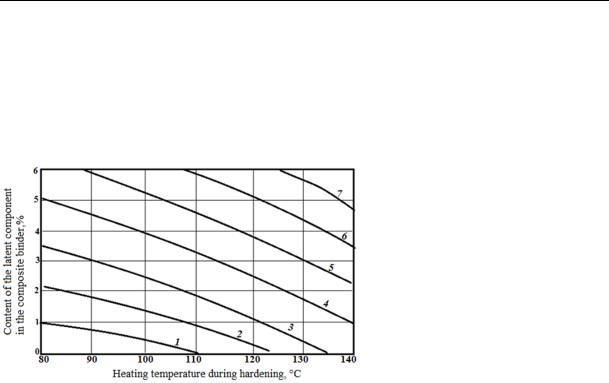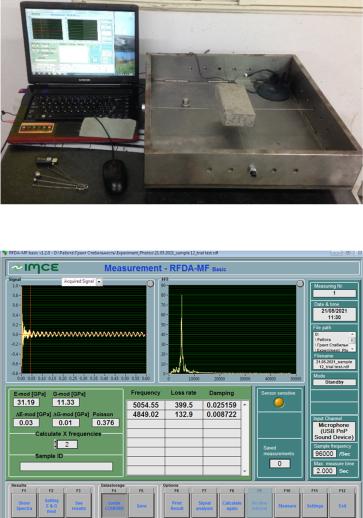
3833
.pdf
Russian Journal of Building Construction and Architecture
A graphical interpretation of the optimized polynomial (2) was carried out and a nomogram of the relationship between the shear strength of the adhesive joint and the consumption of the latent component in the composite binder and the heating temperature during curing was obtained (Fig. 2).
Fig. 2. The relationship between the shear strength of the adhesive joint
and the flow rate of the latent component in the composite binder
and the heating temperature during curing, MPa:
1 –– 2; 2 –– 4; 3 –– 6; 4 –– 8; 5 –– 10; 6 –– 12; 7 –– 14
The optimal content of the latent component in the complex binder is determined by means of the method of analytical optimization:
У |
3.6 1.2Х |
1 |
0 Х |
1 |
|
1.2 |
0.33. |
|
|
||||||
Х1 |
|
3.6 |
|
||||
We carry out the transition from coded values to natural ones:
Rl = 3.0 + 2.5×0.33 = 3.7±0.1 %.
Taking into account the experimental error (5 %), the optimal content of the latent component should be within the range of 3.6––4.0 %.
As a result of the experiment, it was found that with a low content of the latent component of the composite binder, i.e., with compositions close to pure epoxide, the shear strength of the adhesive joint reduces significantly.
The combined effect of the flow rate of the latent component and the heating temperature on the contact strength is significantly and inversely proportional, i.e., the strength increases (with changing factors in the intervals of the experimental conditions) as does the flow rate of the latent component and the heating temperature decreases, or the other way around as the flow rate of the latent component and temperature decrease. The optimal content of the latent component is within the range of 3.6¬ to 4.0 %, and the optimal consumption of the modifier is within the range of 2.5 to 2.7 % by the weight of the binder.
50
Issue № 4 (52), 2021 |
ISSN 2542-0526 |
The energy efficiency of new technological solutions was evaluated by the change in heat loss during heat treatment of mineral wool cylinders. Lowering the curing temperature of the epoxy binder on latent hardeners to 80––110 °C allowed us to reduce the heat treatment temperature to 100 °C, while for thecuring ofphenolicalcohols, thecoolant temperaturewas250––260 °C.
The heat content of the heat flux (kW) was taken as an evaluation criterion. In the first case, it was 913 kW, in the second 365. In relative units, the decrease in heat consumption by heat flux was (913 – 365) / 913 = 0.6 (or 60 %).
As for the energy performance of production of mineral wool cylinders, it is necessary to take into account the energy component associated with the production of mineral fiber, energy consumption for technological needs, etc. In this case, the estimated economic effect of reducing the heat treatment temperature by 150 °C is assumed to be 20––30 %.
The developed methodology for calculating the thickness of the insulating layer according to the standard value of the specific heat flux made it possible to establish the optimal flow rate of the insulating material, which enabled its consumption in insulation systems to be optimized both for thermal devices operating at temperatures not exceeding 80 °C and for devices and pipelines with an operating temperature of more than 100 °C.
Conclusions. The products for thermal insulation of hot water pipelines were manufactured using less energy-intensive technologies and, in particular, a binder based on epoxy resins that cured at significantly lower temperatures than the binders based on phenol compounds, have been developed.
The studies took into account that epoxy adhesives have good adhesion to glass and metal, as well as chemical resistance and resistance to solvents and easily and quickly cure almost without emission of volatile substances. Small shrinkage during curing promotes the formation of adhesive films with a low level of stress, which is specifically important at monolithic contacts of mineral fibers.
The scientific foundation of energy-saving technology for mineral fiber cylinders with the increased strength and operational stability, as well as the development of an energy-efficient technical thermal insulation system using mineral wool cylinders have been completed.
The result of the research was the rationale for the use of a complex epoxy binder on latent hardeners. Having obtained a low toxic binder for mineral wool products, one can reduce the curing temperature of the binder to 100 °C. The economic calculations justified a reduction in the energy consumption in the manufacture of products by 20–30 % while maintaining regulatory conditions for the maximum heat flow.
51

Russian Journal of Building Construction and Architecture
References
1.Quagliarini E., Lenci S., Monni F. Basalt fiber ropes and rods: durability tests for their use in building engineering. Journal of Building Engineering, 2016, vol. 5, pp: 142––150. doi: 10.1016/j.jobe.2015.12.003.
2.Bauer E., Pavon E., De Castro E.K., Barreira E. Analysis of building façade defects using infrared
thermography: laboratory studies. Journal of Building Engineering, 2016, vol. 6, pp. 93––104. doi: 10.1016/j.jobe.2016.02.012.
3.Zhuk P. M., Zhukov A. D. The regulatory framework for the environmental assessment of building materi-
als: prospects for improvement. Ecology and Industry of Russia, 2018, vol. 22, no. 4, pp. 52–57. doi: 10.18412/ 1816-0395-2018-4-52-57.
4.Belussi L., Barozzi B., Bellazzi A., Danza L., Devitofrancesco A., Fanciulli C., Ghellere M., Guazzi G.,
Meroni I., Salamone F., Scamoni F., Scrosati C. A review of performance of zero energy buildings and energy efficiency solutions. Journal of Building Engineering, 2019, vol. 25, pp. 100172. doi: 10.1016/j.jobe.2019.100772
5.Shen X., Li L., Cui W., Feng Y. Coupled heat and moisture transfer in building material with freezing
and thawing process. Journal of Building Engineering, 2018, vol. 20, pp: 609––615. doi: 10.1016/j.jobe.2018.07.026
6.Ibrahim O., Younes R. Progress to global strategy for management of energy systems. Journal of Building Engineering, 2018, vol. 20, pp: 303-316. doi: 10.1016/j.jobe.2018.07.020
7.Zhukov A., Semyonov V., Gnip I., Vaitkus S. The research on expanded polystyrene creep behavior. MATEC Web of Conferences, 24 July 2017, vol. 117, Seminar 2017 Theoretical Foundation of Civil Engineering, RSP 2017, Warsaw, Poland, 19 August 2017 to 21 August 2017.
8.Gouri M., Bachiri A., Hegazi S.E., Rafik M., Harfi A. Thermal degradation of a reactive flame retardant based on cyclotriphosphazene and its blend with DGEBA epoxy resin. Polymer Degradation and Stability, 2009, vol. 94, no. 11, рр. 2101–2106. doi: 10.1007/s11998-014-9579-6
9.Da Eun Lee, Hyun Woo Kim, Byung-Seon Kong, Hyung Ouk Choi A study on the curing kinetics of epoxy molding compounds with various latent catalysts using differential scanning calorimetry. J. Appl. Polym. Sci. 2017. doi: 10.1002/APP.45252
10.Rumyantsev B. M., Zhukov A. D., Zelenshikov D. B., Chkunin A. S., Ivanov K. K., Sazonova Yu. V. Insu-
lation systems of the building construtions. MATEC Web of Conferences, 2016, vol. 86. doi: 10.1051/matecconf/ 20168604027
11.Nardi L., Perilli S., De Rubeis T., Sfarra S., Ambrosini D. Influence of insulation defects on the thermal performance of walls, an experimental and numerical research. Journal of Building Engineering, 2019, vol. 21, pp. 355––365. doi: 10.1016/j.jobe.2018.10.029
12.Funk M. Hysteretic moisture properties of porous materials: Part 1: Thermodynamics. Journal of building physics, 2014, vol. 38, no. 1, pp. 6––49. doi: 10.1177/1744259113496367
13.Zhukov A. D., Ter-Zakaryan K. A., Semenov V. S. Insulation systems with the expanded polyethylene
application. ScienceDirect IFAC PaperOnLine, 2018, vol. 51, iss. 30, pp. 803––807. doi: 10.1016/j.ifacol.2018.11.191.
14.Aldawi F., Alam F., Date A., Kumar A., Rasul M. Thermal performance modelling of residential house wall systems. Procedia Engineering, 2012, vol. 49, рр. 161––168.
15.Lee D. S., Han C. D. Effect of the chemical structure of low–profile additives on the curing behavior and chemorheologyof unsaturated polyester resin. Polym. Eng. Sci., 1987, vol. 27, no. 13, pp. 964––975.
16.Gonzalez–Romero V. M., Macosko C. W. Viscosity rise during free radical crosslinking polymerization with inhibition. J. Rheology, 1985, vol. 29, no. 3, pp. 259––272.
17.Mansourian-Tabaei M., Jafari S. H., Khonakdar H. A. Lap shear strength and thermal stability of diglycidyl ether of bisphenol a/epoxy novolac adhesives with nanoreinforcing fillers. J. Appl. Polym. Sci., 2014. doi: 10.1002/APP.40017
18.Orlik-Kozdon B., Steidl T. Effect of the air channels in thermal insulating material on its thermal resistance. Journal of building physics, 2016, vol. 39, no. 5, рр. 461––470. doi: 10.1177/1744259115599957
19.Zhukov A., Medvedev A., Poserenin A., Efimov B. Ecological and energy efficiency of insulating systems 03070. E3S Web of Conferences (ITESE-2019), vol. 135(2019), published online: 04 December 2019. doi: 10.1051/e3sconf/201913503070
20.Rumyantsev B. M., Zhukov A. D., Bobrova E. Yu, Romanova I. P., Zelenshikov D. B., Smirnova T. V. The systems of insulation and a methodology for assessing the durability. MATEC Web of Conferences, 2016, vol. 86. doi: 10.1051/matecconf/ 20168604036.
52

Issue № 4 (52), 2021 |
ISSN 2542-0526 |
DOI10.36622/VSTU.2021.52.4.005
UDC691.33
I. Popov 1, A. Levchenko 2
EXPERIMENTAL INVESTIGATION OF INTERNAL FRICTION
IN RUBBER CONCRETE AND FIBER-REINFORCED RUBBER CONCRETE*
Voronezh State Technical University 1, 2
Voronezh, Russia
1PhD in Engineering, Researcher of the Research Center on Dynamics of Solids and Structures, e-mail: 89042149140@mail.ru
2PhD Candidate, Lecturer of the Dept. of Building Structures, Soils and Foundations
named after Professor Yu. M. Borisov, e-mail: alevchenko@vgasu.vrn.ru
Statement of the problem. The paper is devoted to the experimental identification of damping for such materials as butadiene rubber (BR) and cis-butadiene low-molecular weight rubber (SKDN-N) based concrete and fiber-reinforced rubber concrete by means of the Impulse Excitation Technique (IET).
Results. It was found that BR based concrete with or without fiber-reinforcement shows more obvious viscoelastic properties than the corresponding materials based on SKDN-N rubber. The addition of steel fiber reduces internal friction in the material, while propylene fiber has the opposite effect. This is due to the fact that the fibrous propylene acts as an additional damping material, which enhances energydissipation under dynamic loading.
Conclusion. The internal friction in the rubber concrete and fiber-reinforced rubber concrete was measured for the first time. The obtained data are the additional microstructural characteristics of polymer concrete, which describes its viscosity. The real values of the investigated quantities have been determined, which makes it possible to use the models with fractional derivatives in the calculations of building structures made of rubber concrete and fiber-reinforced rubber concrete for dynamic loads, taking into account the phenomenon of viscoelasticity.
Keywords: internal friction, rubber concrete, fiber-reinforced rubber concrete, impulse excitation technique.
Introduction. In traditional engineering practice, while performing structural calculations, the assumption that the material is purely elastic is commonly made. In the case of static loads, it is fully justified, since the calculation results are in good agreement with the actual values.
However, when dynamic loads are applied, significant differences often arise between the numerical results and the stresses experimentally determined in the elements of actual building structures. This is due to inadequate consideration of the material properties of constructions used in calculations with further adoption of an incorrect engineering decision, which results in material damage and even loss of life. Strictly speaking, perfectly elastic materials
© Popov I., Levchenko A., 2021
* This research has been supported by the Russian Foundation for Basic Research, Project No. 20-38-70143- Stability. The experimental studies have been carried out using the facilities of the Collective Research Center named after Professor Yu. M. Borisov, Voronezh State Technical University, which is partly supported by the Ministryof Science and Education of the Russian Federation, Contract No 075-15-2021-662.
53

Russian Journal of Building Construction and Architecture
do not exist. All materials are to some extent viscoelastic, i.e., they have both elastic and viscous properties. Taking the phenomenon of viscoelasticity into account allows one to obtain more reliable results of structural calculations considering dynamic effects.
Internal friction, or damping, is an important characteristic describing the viscoelastic behaviour of materials. One of the first fundamental studies in the field of studying the internal friction in metals were conducted by Postnikov [14] and Meshkov [10]. In the monograph [14], the essence of the damping phenomenon in metals has been investigated in sufficient detail, and a classification of the internal friction types based on the nature of its origin has been provided, as well as the results of experimental measurements of internal friction in metals. Postnikov [14] summarized the models of the existing torsion pendulums, gave their detailed description and presented the corresponding drawings. Meshkov [10], in addition to the classification of the types of internal friction in metals, also considered the foundations of the theory of relaxation processes in metals which were studied by Academician Rabotnov [17–– 19]. Later, Lakes [21] presented a review of modern experimental methods for measuring the viscoelastic characteristics of materials, including resonance, and described modernized torsional pendulums. Blatner et al. [20] described in detail the theoretical foundations and gave a clear definition of internal friction, and also demonstrated the results of experiments on measuring internal friction for various metals.
The authors of the present paper have studied internal friction in concrete under the assumption that concrete is a viscoelastic material with time-depending viscosity [22––25]. It has been found that internal friction in concrete decreases during the process of hardening and strengthening. The most significant changes occur at ages up to 14 days, further this trend becomes less and less obvious. This is due to microstructural changes in the concrete material during its hardening and strengthening when the viscous properties gradually disappear, while the elastic properties begin to dominate.
Despite lots of studies in the field of determining internal friction, this issue remains poorly studied for many viscoelastic building materials under dynamic loading. Indeed, once new materials are introduced into production, it becomes necessary to study them in detail in order to fully understand all the processes occurring in the structure of the material under various external impacts. As for rubber concrete, i.e., cis-butadiene low-molecular weight rubber (SKDN-N) and butadiene-rubber (BR) based concrete and fiber-reinforced rubber concrete, then, to the best of the authors’ knowledge, the process of internal friction as a dissipation of mechanical energy has not been previously studied. The developers of these materials and
54

Issue № 4 (52), 2021 |
ISSN 2542-0526 |
their followers have carried out a number of extensive studies of the materials themselves, as well as reinforced structures made of such materials [1––9, 11, 12, 15, 16]. High compressive [3, 11, 7] and bending [5, 9] strength, crack resistance, resistance to aggressive media [11], as well as a number of other mechanical and operational characteristics were revealed. An immense contribution to the development and investigation ofthese materials has been made by Borisov [2]. However, the research of these materials has not been completed, since dynamic tests of SKDN-N and BR based concrete and fiber-reinforced rubber concrete have not yet been carried out. Moreover, the study of internal friction and its influence on the mechanical characteristics of materials under dynamic loads are of particular scientific interest, because the above-mentioned polymer concretes has already received a practical application in construction as a material for load-bearing structuresoperating in aggressive environments.
Therefore in order to completely understand the behavior of these materials under dynamic loads, a full account of their viscoelastic properties is needed by means of new studies of internal friction.
1. Internal friction definition. Several definitions and measures of internal friction are given in the literature. In most works [10, 14, 20], it is defined as the dissipation of energy in a material under dynamic loading.
There are different measures of internal friction. When applying cyclic loading to a material, the specific damping capacity
W W , |
(1) |
or the loss factor W 2πW , and the quality factor |
|
Q 2πW W , |
(2) |
are introduced to describe the damping phenomena. Here, W is the maximum elastic energy stored during one cycle, and W is the corresponding energy absorption during that cycle [14, 20].
A common measure of damping in the literature is reciprocal of the quality factor, Q 1 :
Q 1 |
W |
2π . |
(3) |
|
|||
|
2πW |
|
|
The sinusoidally varying stress and strain, respectively, could be expressed as follows: |
|
||
σ* σ0ei t, |
(4) |
ε* ε ei( t ) (ε' iε")ei t , |
(5) |
0 |
|
and the complex modulusE*( )could be written as
55

Russian Journal of Building Construction and Architecture
E* |
* |
E ei ( ) E'( ) E"( ), |
(6) |
|
* |
||||
|
|
|
where is the phase lag between stress and strain, ω is the frequency of vibrations, E' is the
storage modulus, and E" is the loss modulus. In such a situation, the internal friction |
Q 1 |
||||||||||
could be defined as [10, 14] |
|
|
|
|
|
|
|
|
|||
Q 1 |
W |
tan |
E" |
. |
(7) |
||||||
|
|
|
|||||||||
|
2 W |
|
|
|
|
|
E' |
|
|||
Considering a free vibrating material, the specific damping capacity could be calculated as |
|
||||||||||
|
|
|
|
|
A |
|
(8) |
||||
|
2ln |
|
n |
, |
|||||||
|
|
|
|||||||||
|
|
|
|
An 1 |
|
||||||
1 |
|
A |
|
|
|
||||||
Q 1 |
|
ln |
n |
|
, |
(9) |
|||||
|
|
|
|||||||||
|
|
|
An 1 |
|
|||||||
where An and An+1 are the corresponding amplitudes ofnth and (n+1)th vibration modes. Considering equations (3)––(9), it is possible to compare the values of internal friction obtained by different methods using different measures [14].
2. Impulse Excitation Technique (IET). Impulse Excitation Technique (IET) is an advanced method to measure such material characteristics as dynamic Young’s and shear moduli, dynamic Poisson’s ratio, and internal friction, to investigate the deformation behavior, softening phenomena and relaxation mechanisms and phase transformations in different materials. The experimental studies can be performed at both room and high temperatures. The method is based on the following. A specimen of a well-defined shape and geometry is being put on a wire support as free as possible. The contact between the wire and the sample surface should be established at certain points, so-called nodes. The support location plays a key role in the damping test. If the supporting points do not coincide with the nodes, the damping will be substantially increased. In such a situation, the damping is determined not by the material, but by the test set-up [26]. For each shape of the sample with particular dimensions, the positions of nodes could be calculated. After a small impact is applied to a sample, it starts vibrating. The signal is detected by a microphone and transmitted to the PC. Resonant Frequency and Damping Analyzer (RFDA) software performs fast Fourier transform (FFT), calculates the resonant frequencies, dynamicelasticand shear moduli, dynamicPoisson’sratio, and internal friction. Damping is characterized by the following ratio:
Q 1 k πω , |
(10) |
r |
|
where k is the loss factor, and r is the resonant frequency.
56
Issue № 4 (52), 2021 |
ISSN 2542-0526 |
More details on IET and its applications for measurements of damping could be found in the review [25].
3. Experimental program. The experimental program of this research consists of two major parts. The first part is devoted to the analysis of such basic materials’ properties as compressive strength, dynamic Young’s modulus, and dynamic Poisson’s ratio. Another part of the program is aimed at the measurement of internal friction. For the damping test, three blocks 160 × 80 × 40 mm have been cast for each set of rubber concrete. Damping measurements have been carried out at the age of 7 days at room temperature.
3.1. Materials and components. To investigate the damping in rubber concretes available in the local industry, two types of rubber were used for making specimens, namely: SKDN-N produced by OJSC Efremov Synthetic Rubber Enterprise (Efremov, Russia) and BR produced by Voronezh Factory of Synthetic Caoutchouc (Voronezh, Russia). In order to evaluate the effect of fiber presence in the mixture and the fiber type on materials’ internal friction, two types of fibers were used: metal fiber made of steel wire taken from tires and propylene fiber. The main components for rubber concretes are the following:
low molecular weight cis-polybutadiene rubber SKDN-N (in accordance with TU 38.103515-2005), which is obtained by the polymerization of butadiene under the action of a catalytic system based on nickel salts and organic aluminum compounds;
technical sulfur (in accordance with GOST 127.1-93) in the form of bright yellow powder with a density of 2070 kg/m3, and with a melting point of 114 0С;
vulcanization activator (zinc oxide ZnO in accordance with GOST 10262-73) in the form of white powder with a density of 5600 ... 5700 kg/m3;
calcium oxide in the form of white powder with a density of 2500 ... 2900 kg/m3 was used as a calcium-containing component;
fly ash from the Voronezh Powerplant with specific area 2500-2700 cm2/g (in accordance with GOST 25818-91);
ordinary Portland Cement M500 produced in Voronezh by CJSC "EUROCEMENT GROUP";
steel fiber made of steel wire taken from tires (in accordance with GOST 14311-85);
propylene fiber (fiber diameter 17––25 μm, fiber length 3 mm) in accordance with EN 14889-2:2006;
quartz stone and gravel (see Table 1).
57

Russian Journal of Building Construction and Architecture
|
Physical properties of aggregate |
Table 1 |
|
|
|
||
|
|
|
|
Aggregate |
Fraction dimensions, mm |
Specific gravity |
Specific area, cm2/g |
Gravel |
5.000 … 10.000 |
2.67 |
5.4 |
Quartz sand |
1.250 … 2.500 |
2.65 |
33.0 |
3.2. Proportions of the specimen mix. The proportions of the specimen mix of rubber concrete could vary. For this experiment with locally available materials, only optimized proportions [2] that are being used in the industry are taken for making specimens. Six sets of rubber concrete have been cast. There are SKDN-N rubber-based concrete itself, and the same material reinforced with steel fiber and with propylene fiber. Analogous compositions are applied to BR based concretes. Sample specifications, marks and their proportions of the specimen mix are shown in Table 2.
Sample specifications, marks and proportions of the specimen mix |
|
Table 2 |
||||
|
|
|||||
|
|
|
|
|
|
|
Component/Sample mark |
SKDNFRRCN PP |
SKDNRC -N |
FRRCSKDNSteelN |
FRRCBR PP |
RCBR |
BRFRRCSteel |
|
|
|
|
|
|
|
|
|
|
|
|
|
|
Low molecular weight rubber BR, % bymass |
–– |
–– |
–– |
8.2 |
8.0 |
8.2 |
Low molecular weight rubber SKDN-N, % bymass |
8.2 |
8,0 |
8.2 |
–– |
–– |
–– |
Sulfur technical, % bymass |
4 |
4.0 |
4.0 |
4 |
4.0 |
4.0 |
Tiuram-D, % bymass |
0.4 |
0.4 |
0.4 |
0.4 |
0.4 |
0.4 |
Zinc Oxide, % bymass |
1.2 |
1.6 |
1.2 |
1.5 |
1.6 |
1.2 |
Calcium Oxide, % bymass |
0.4 |
0.5 |
0.4 |
0.5 |
0.5 |
0.4 |
Flyash, % bymass |
7.8 |
7 |
7.8 |
8 |
7 |
7.8 |
Quartz sand, % bymass |
24.2 |
24 |
24.2 |
23 |
24 |
24.2 |
Gravel, % bymass |
53.45 |
54.5 |
51.3 |
54.05 |
54.5 |
51.3 |
Steel Fiber, % bymass |
–– |
–– |
2.5 |
–– |
–– |
2.5 |
Propylene fiber, % bymass |
0.35 |
–– |
–– |
0.35 |
–– |
–– |
3.3. RFDA Basic experimental setup. The experimental setup is shown in Fig. 1. RFDA (Resonant Frequency and Damping Analyzer) Basic consists of a PC, wire support, RFDA software, a special microphone to receive the signal, and a mechanical impactor. For testing rubber concrete blocks, a steel wire support system has been designed and manufactured. As it was previously shown by the authors [22], the replacement of standards wire support system by a massive steel wire support does not affect the measurements. The principle is based on the IET. The input parameters are the following: sample shape (dropdown menu), sample di-
58

Issue № 4 (52), 2021 |
ISSN 2542-0526 |
mensions, sample mass, calculation mode, and the value for dynamic Poisson’s ratio for the first iteration. The software automatically calculates the positions of the nodal points. As the output, the dynamic Young’s and shear moduli, dynamic Poisson’s ratio, resonant frequencies, loss factor and internal friction could be obtained (see Fig. 2).
Fig. 1. Experimental setup for the damping test
Fig. 2. Resonant Frequencyand Damping Analyzer software output
4. Results and discussion. Compressive strength results for rubber concretes are presented in Fig. 3. Unlike Ordinary Portland Cement (OPC) concretes, the design compressive strength of rubber concrete is established during the first day, and it remains almost unchanged for a long time [2]. Comparing RC_SKDN-N with RC_BR, FRRC_SKDN_N_PP with FRRC_BR_PP and FRRC_SKDN_N_Steel with FRRC_BR_Steel in terms of their compressive strength values, it could be noted that BR-based rubber concretes perform from 12 to 13 per cent higher values of the compressive strength rather that SKDN-N rubber-based concretes. For both, SKDN-N and BR addition of 0.35 % by mass of propylene fibre increase compressive
59
